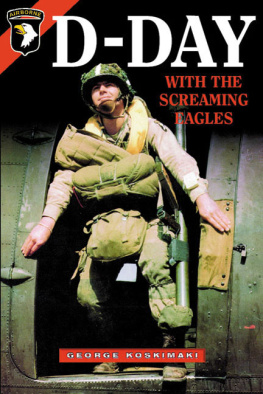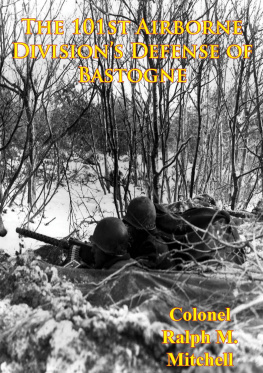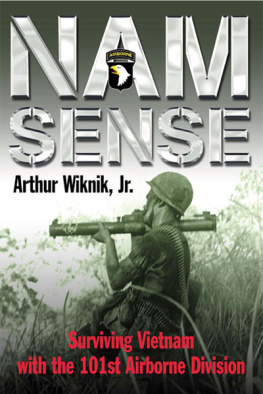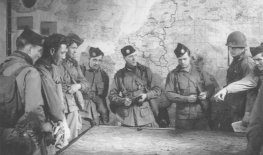
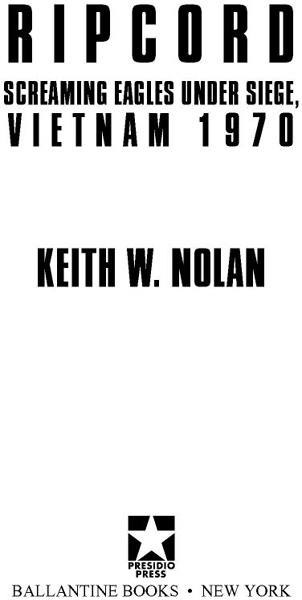
Table of Contents
For my wife, Kelly, and our daughter, Anna Britt
AN ABSOLUTELY SUPERBACCOUNT OF WAR AT THELEVEL OF THE INDIVIDUALSOLDIER...
This is a major contribution to Vietnam War literature, particularly of action at the small-unit level.
Military Review
Keith Nolans research, his comprehension of the political as well as the military actions, his careful concern for those who were there, and, most of all, his writing, are superb. I recommend Ripcord without stint or reservation.
STEPHEN AMBROSE
With Ripcord, Keith Nolan has added another significant battle history to his impressive list of works on the Vietnam War.
JOHN DEL VECCHIO
Author of The 13th Valley
The U.S. Army and Marine Corps have their Boswell in Keith Nolan, whose twenty years of dedicated research have resulted in ten superb books about the Vietnam War. Ripcord is his best yet.
LT. COL. GARY D. SOLIS, USMC (Ret.)
Author of Son Thang
NOLAN ONCE AGAINCAPTURES THE STARKREALITY OF COMBATIN VIETNAM.
U.S. Naval Institute Proceedings
Ripcord is the story of one of the last major engagements between U.S. military forces in the Republic of Vietnam and elements of the North Vietnamese Army (NVA). However, readers should not be surprised if this battle is unknown to them. Astonishingly, it went virtually unreported by the media at the time, largely because of the close wraps imposed by the Military Assistance Command Vietnam headquarters in Saigon, which feared that the heavy U.S. casualty lists might touch off a second Hamburger Hill debate on the floor of the U.S. Senate. Thus, even thirty years after the event, this is not a battle that will be recalled by many, save the participants themselves and the few who may have read of it in an after-action report, or perhaps through the occasional professional journal. That is to say, it was an unknown battle until Keith Nolan rightly decided that this is a story that had to be told....Military professionals and historians alike will be gratified that Mr. Nolan made that decision.
Marine Corps Gazette
WELL WRITTEN AND THOROUGHLY RESEARCHED...
[Ripcord] evokes admiration for American and North Vietnamese infantry soldiers engaged in intense fighting and contempt for what passed for American higher military and political leadership....This is powerful stuff. How did it happen? Why the thirty-year wait to get the whole story?...U.S. soldiers knew what to do. They fought and died. But American senior commanders were indecisive, even petty. They were torn between doing what was necessary to win the battlecommit more combat strengthand an awareness that a bloodbath like that on Hamburger Hill [a few miles away and a year earlier] was unacceptable in 1970....This reviewer thinks Nolan got it right and tells it well.
DR. HENRY G. GOLE, Colonel, USA (Ret.)
A combat infantryman in Korea and Vietnam U.S. Army War College Parameters
Astoundingly, the battle at Ripcord went virtually unreported at the time; thus this book ranks not just as another saga of the war, but as a real and original contribution to military history.
DONALD KIRK
Author of Tell It to the Dead
Gripping...Meticulously researched...Deliberately kept out of the news at the time...the battle for Ripcord is finally told here. It is well worth reading as a searing narrative of soldiers and small units in battle...and as a microcosm of Americas last painful year in Vietnam.
LT. GEN. JOHN H. CUSHMAN, USA (Ret.)
U.S. Naval Institute Proceedings
Books published by The Random House Ballantine Publishing Group are available at quantity discounts on bulk purchases for premium, educational, fund-raising, and special sales use. For details, please call 1-800-733-3000.
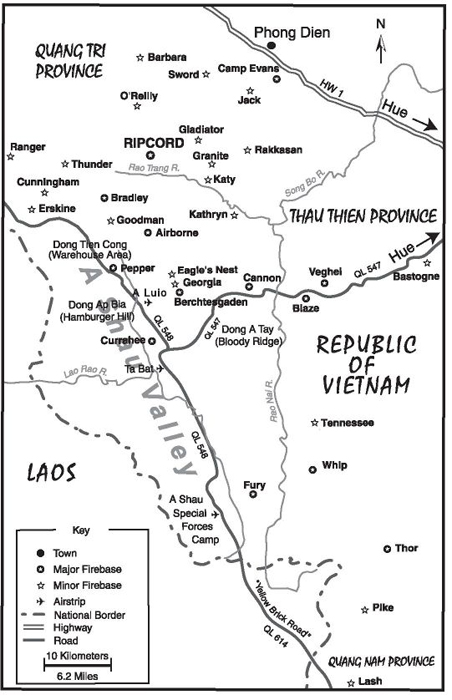
(For a detailed map of hill country around Firebase Ripcord, see page 242.)
Introduction
Firebase Ripcord was originally established by the 2d of the 506th, a line infantry battalion commanded by Lt. Col. Andre C. Lucas, to support an offensive into an enemy base area overlooking the A Shau Valley of Thua Thien Province, Republic of Vietnam. Occupying the denuded crest of a ridge, the firebase was a whitish brown hump amid jungle-covered mountains. East of the firebase, the mountains descend to foothills, also jungled, beyond which, barely visible from Ripcord, sandy plains meet the South China Sea. To the west, the green peaks push successively skyward; along the far horizon stretch the great mountain ranges that originate in central China and dominate the entire frontier between Vietnam and Laos.
Dependent on helicopters for logistical support, Ripcord was less than twenty-five kilometers, a fifteen-minute flight, southwest of Camp Evans, the rear area of Lucass battalion and its parent command, the 3d Brigade, 101st Airborne Division (Airmobile). Ripcord was nevertheless deep enough in the mountains, closer to Laos than its own support base, that the heavier of the two howitzer batteries on site could fire southwest into the enemy-controlled A Shau Valley. More to the point, both batteries could range on the supply installations on Co Pung Mountain, a major terrain feature immediately northeast of the valley and nine kilometers south of Ripcord. Those supply installations and the two North Vietnamese regiments that protected them were the objective of the planned offensive. Fighter-bombers utilized a navigational beacon positioned on the firebase to further soften up the area with air strikes, as didflying too high to be seen or heardB-52 Stratofortresses of the U.S. Air Forces Strategic Air Command.
No more than a bare hilltop when first established, Ripcord was two and a half months later a heavily bunkered bastion standing ready to provide artillery coverage for the opening of three firebases directly in the objective area. It was at that time, on the eve of the allied offensive, that the enemy struck at the intruders in their mountains. Mortar crews began shelling Ripcord early one morning, and small teams of enemy infantry engaged those units that choppered in to silence the mortars. Resupply helicopters came under heavy antiaircraft fire; two were downed. In a terrible finale to that first day of surprises, a sapper force penetrated the perimeter of a company bivouacked for the night on a strategic peak two and a half kilometers southwest of Ripcord and demolished the unit from the inside out. The sappers themselves also suffered heavy losses.
Thus began the battle for Firebase Ripcord. Colonel Benjamin L. Harrison, the brigade commander, was given operational control of the division reserve, a full battalion, but it was not enough. The enemy had prepared the battlefield too well. Moving down trails hidden under the canopy, several North Vietnamese battalionsthe exact number remains unclearhad slipped bit by bit into the hills around Ripcord during the quiet days before the storm. Advance parties had prepared extensive bunker complexes for them, all superbly camouflaged, and laid in supplies. They had also dug firing pits for 60mm and 82mm mortars, as well as enough .51-caliber machine-gun positions to ensure that helicopters approaching the firebase could be tracked from any direction.
Next page

